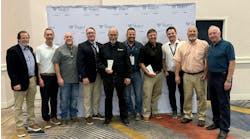Latest from Plumbing
Sponsored
Morrison, Colo. — “You installed a track cooling system?” It's a question members of the Bandimere family have heard many times over the past several weeks following their installation of a racetrack cooling system. The Bandimere Speedway's new racing surface is now suited to greet the ground-pounding power of drag racing - a cooler track gives better traction, propelling dragsters forward, faster.
Last year, the speedway's management team decided that they would mark the 50th anniversary of Bandimere Speedway in Morrison, Colo., by installing the nation's first track cooling system.
No time to waste
By December 2007, the facility's crew had the second (non-cooled) half of the racetrack concrete poured and leveled. Tearing up the section to receive the radiant cooling system was to be completed next.
All the concrete from the ⅛-mile mark to the ¼-mile mark was removed to make room for a new 200-ft. stretch of concrete track, a slab 8" deep and 17-ft. wide for each of two lanes (the cooled slab begins 40-ft. behind the starting line).
The raceway replaced all asphalt with an additional 900 cu.yd. of new concrete - from the 660-ft. mark to the finish line at 1,320-ft., plus an additional 60-ft. past the finish line, adding to all of the new track area that's cooled.
“With a track cooling system in place, we'll have a healthier track and improved race times overall,” explained Larry Crispe, vice president of facility operations at Bandimere.
“We expected to see fluid temperatures entering the track between 50° and 54° with the addition of a chiller and cooling tower, and steadily improved track times,” said Jeff Sipes, media relations manager at Bandimere.
“The purpose of the system's design - in addition to cooling the starting lanes of the race track - was to even-out the temperatures for both east and west lanes,” commented Brandon Thompson, system design engineer at Thompson Engineering. Thompson worked closely with Him Ly, commercial sales engineer for Uponor in Apple Valley, Minn. According to Thompson, their initial design calculations determined that track temperatures could be lowered by 20°.
The new track cooling system is designed to act like a radiant heat system in reverse. Rather that supplying heat, its job will be to send chilled water into a network of embedded Uponor PEX tubing to draw heat out of the concrete slab, wicking away heat faster than the sun supplies it.
The cooling system circulates 110-gal. of water per minute, removing just over one million Btuh per hour.
According to Rick Meek, vice president of TM Sales, a manufacturer's rep firm in Denver, the “heart” of the cooling system is a pair of highly efficient, in-line, vertical, multi-stage Grundfos CR pumps with a cartridge-type mechanical shaft seal.
“The pumps chosen for the job are ideal because they're stainless steel, and have multiple impellers for high head and accommodate low suction inlet pressure,” stated Meek. “Stainless steel was an important feature because the entire cooling system is an open loop - new oxygen enters the liquid volume constantly, and this would deteriorate other metals.”
The pump's multiple impeller design is a benefit because circulator pump suction is set at a level seven feet above the water in the tanks. The first impeller's NPSH capability is the key; other impellers have sufficient NPSH once the pump activates because the first stage pumps into the second stage, and so on.
According to Meek, another key advantage comes from the pump's enclosed fan-cooled design and its vertical (small footprint) design. With a very small base, the pumps help to conserve room within the small, subterranean mechanical “pit.”
Each lane has an insulated 12,000-gal. storage tank buried outside the guard walls to the east side. Three inches below the surface is 15,000-ft. of ¾” Uponor AQUAPEX tubing in 30 500-ft. loops, spaced on 6” centers for serious cooling of the above surface.
The stainless steel Grundfos pumps and non-barrier AQUAPEX were specified because the cooling tower will introduce new oxygen into the water continuously, making it an open system. Oxygen will enter the system while having no negative effect.
The Bandimere's track cooling system, is now the largest in this country.

